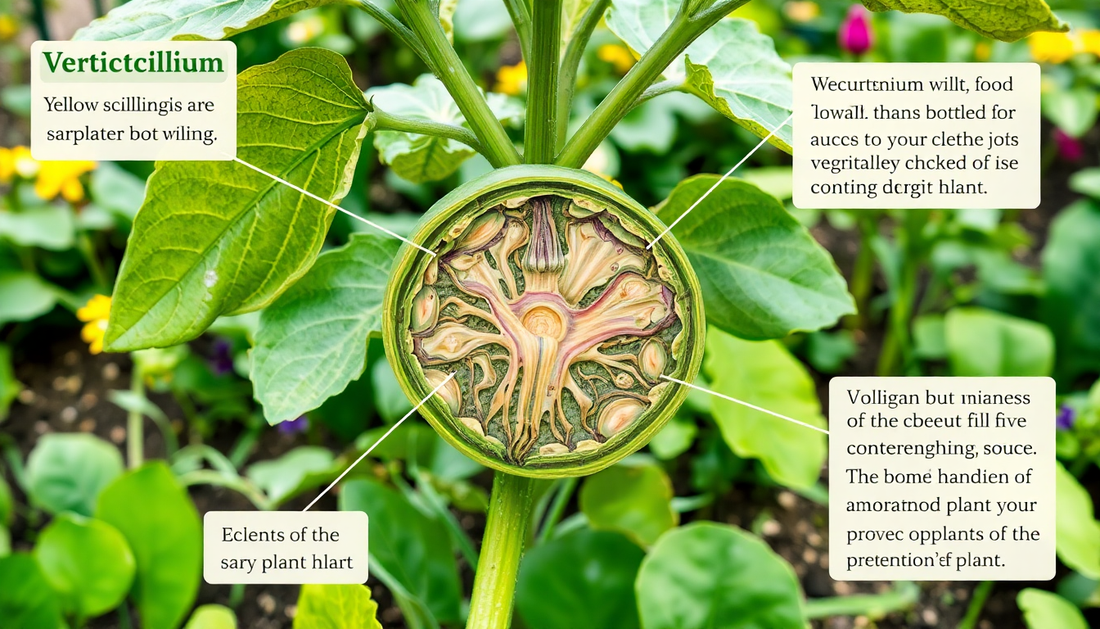
Preventing and Treating Verticillium Wilt in Your Vegetable Garden
Verticillium wilt is a common and devastating fungal disease that can wreak havoc on your vegetable garden. This soil-borne pathogen can infect a wide range of plants, including tomatoes, potatoes, eggplants, peppers, and many others. Once established in the soil, it can persist for years, making it a formidable challenge for gardeners.
In this comprehensive guide, we'll explore the causes, symptoms, and effective strategies for preventing and treating verticillium wilt in your vegetable garden. With the right knowledge and proactive measures, you can protect your plants and ensure a bountiful harvest.
Understanding Verticillium Wilt
Verticillium wilt is caused by a group of soil-borne fungi, primarily Verticillium dahliae and Verticillium albo-atrum. These fungi can infect the plant's vascular system, disrupting the flow of water and nutrients, ultimately leading to the plant's decline and potential death.
The fungi can survive in the soil for many years, even in the absence of a host plant. They can also be spread through contaminated tools, irrigation water, or infected plant material. Once established, the fungi can be extremely difficult to eradicate, making prevention a crucial aspect of managing this disease.
Recognizing the Symptoms
Identifying the symptoms of verticillium wilt is the first step in addressing the problem. The most common signs include:
- Wilting and yellowing of leaves, often starting on one side of the plant
- Stunted growth and reduced vigor
- Discoloration of the vascular system, visible when cutting into the stem
- Premature defoliation and plant death
It's important to note that these symptoms can also be caused by other factors, such as drought, nutrient deficiencies, or other diseases. Careful observation and, in some cases, laboratory testing may be necessary to confirm the presence of verticillium wilt.
Preventing Verticillium Wilt
Prevention is the best approach when it comes to managing verticillium wilt. Here are some effective strategies to implement in your vegetable garden:
1. Soil Preparation
Ensure that your soil is well-drained and rich in organic matter. The fungi thrive in heavy, compacted soils with poor drainage. Amend your soil with compost, aged manure, or other organic materials to improve its structure and fertility.
2. Crop Rotation
Rotate your vegetable crops, avoiding planting susceptible plants in the same area for several years. This can help break the disease cycle and prevent the buildup of the fungus in the soil.
3. Use Resistant Varieties
Look for vegetable varieties that are resistant or tolerant to verticillium wilt. Many seed companies and nurseries now offer cultivars with built-in resistance, which can significantly reduce the risk of infection.
4. Disinfect Tools and Equipment
Clean and disinfect your gardening tools, such as pruners, shovels, and hoes, before moving from one area of the garden to another. This can help prevent the spread of the fungus through contaminated equipment.
5. Manage Irrigation
Avoid overhead irrigation, as it can splash soil-borne pathogens onto the plant's foliage. Instead, use drip irrigation or soaker hoses to deliver water directly to the root zone.
6. Maintain Optimal Plant Health
Ensure that your plants are receiving the proper nutrients and are not stressed by drought or other environmental factors. Healthy, vigorous plants are better equipped to withstand and recover from fungal infections.
Treating Verticillium Wilt
If you suspect your plants are infected with verticillium wilt, it's essential to act quickly to minimize the damage and prevent the spread of the disease. Here are some steps to take:
1. Identify and Remove Affected Plants
Carefully inspect your plants and remove any that show clear signs of verticillium wilt, such as wilting, yellowing, or discolored vascular tissue. Dispose of the affected plants in the trash, not in your compost pile, to prevent the spread of the fungus.
2. Improve Soil Conditions
Amend the soil with organic matter, such as compost or well-rotted manure, to improve drainage and overall soil health. This can help support the growth of healthy, disease-resistant plants.
3. Consider Soil Solarization
Soil solarization is a technique that uses the sun's heat to kill soil-borne pathogens, including the verticillium fungus. Cover the affected area with a clear plastic tarp during the hottest months of the year to create a "greenhouse" effect and eliminate the fungus.
4. Use Biological Controls
Certain beneficial microorganisms, such as Trichoderma fungi or Bacillus bacteria, can be used as biological control agents to suppress the growth of the verticillium fungus. These products can be applied to the soil or used as seed treatments.
5. Avoid Replanting Susceptible Crops
If you've had a severe outbreak of verticillium wilt, it's best to avoid replanting susceptible crops, such as tomatoes, potatoes, or eggplants, in the affected area for several years. Instead, consider growing resistant crops or cover crops to help reduce the fungal population in the soil.
Dealing with verticillium wilt can be a challenging task, but with a comprehensive approach that combines prevention, early detection, and targeted treatment, you can protect your vegetable garden and enjoy a bountiful harvest. Remember, patience and persistence are key when it comes to managing this persistent fungal disease.
Conclusion
Verticillium wilt is a formidable foe in the vegetable garden, but with the right knowledge and proactive measures, you can prevent and manage this disease effectively. By understanding the causes, recognizing the symptoms, and implementing a multi-faceted approach to prevention and treatment, you can safeguard your plants and ensure a thriving, productive vegetable garden.
Stay vigilant, keep your soil healthy, and don't hesitate to seek professional advice if you're unsure about the best course of action. With dedication and a little bit of know-how, you can overcome the challenges posed by verticillium wilt and enjoy a bountiful harvest year after year.






No comments